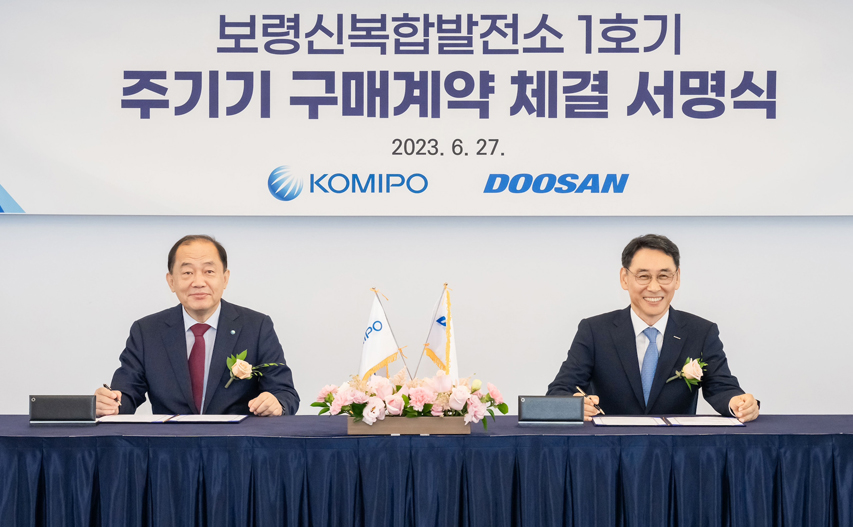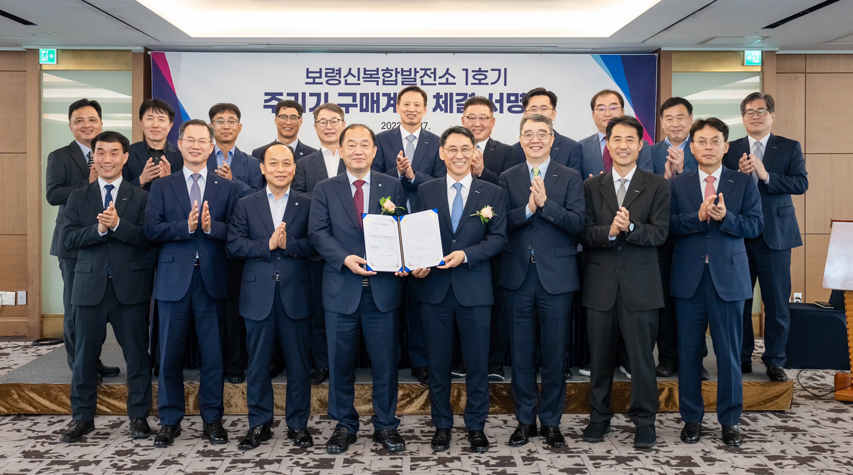The construction of a Korean-standard combined cycle power plant is being pursued in earnest using homegrown Korean technology.
On June 28th, Doosan Enerbility announced that it had signed a contract valued to be KRW 280 billion with Korean Midland Power Co. (KOMIPO) on supplying the main components for the Boryeong New Combined Cycle Power Plant. The signing ceremony which was held at the Lotte Hotel Seoul was attended by key figures from the two companies, including Hobin Kim, CEO of KOMIPO, and Yeonin Jung, President & COO of Doosan Enerbility.
The Boryeong New Combined Cycle Power Plant is the first project to have a Korean-standard combined cycle gas turbine model applied. The gas-fired combined cycle power plants in Korea until now had applied various types of foreign-made gas turbine models, which led to numerous difficulties in achieving efficient maintenance services. As such, Doosan Enerbility made efforts that led to the successful development of a large-size gas turbine for power plants in 2019, one that was made exclusively with homegrown technology. Since 2021, Doosan has been engaged in a state-led project with 340 parties in the domestic industry, academia and research sectors on developing a Korean-standard combined cycle gas turbine model.
The Boryeong New Combined Cycle Power Plant, which has a total capacity of 569MW, is slated to be built by June 2026 in Boryeong city of the South Chungcheong Province. In addition to the 380MW H-class* ultra-large** gas turbine, Doosan will also be supplying a steam turbine and heat recovery steam generators (HRSGs). Gas turbines can be converted to hydrogen gas turbines***, which emit less carbon dioxide, by replacing the combustor nozzle and other certain components. KOMIPO has plans to convert the Boryeong New Combined Cycle Power Plant to a hydrogen combined cycle power plant to achieve its goal of carbon neutrality by 2050.* High-efficiency turbine that is made out of superalloy and designed to withstand high temperatures going up to 1500℃ or higher** Gas turbines can be categorized by its generation capacity into small-size (20~99.9MW), mid-size (100~214.9MW), large-size (215~299.9MW) and ultra-large (300MW+) turbines (Source: McCoy Report)*** Eco-friendly turbine that emits less CO2 by applying LNG-hydrogen co-firing or 100% hydrogen firing for combustion.
Doosan Enerbility is picking up the pace for development of the high-efficiency H-class hydrogen gas turbine, a project it has been pursuing together with parties in the domestic industry, academia and research sectors. As part of the national project led by the Ministry of Trade, Industry and Energy (MOTIE) for development of a high-efficiency H-class hydrogen gas turbine, the technology for 50% hydrogen co-firing is currently being developed and once completed, it will be applied to a demonstration project conducted on Korea East-West Power (EWP)’s Ulsan Combined Cycle Power Plant. Furthermore, a 400MW ultra-large 100% hydrogen-fueled gas turbine, the first of its kind in the world, is also being developed with the target deadline of 2027. Compared to the existing hydrogen gas turbine (E-class), the H-class hydrogen gas turbine provides benefits, such as saving on approximately KRW 60 billion in annual fuel costs and a reduction of approximately 50 thousand tons* in annual carbon emissions.* Assuming it is for a 400MW power plant and with 50% hydrogen co-firing technology, an annual operating rate of 50% and KOGAS’ average rate and hydrogen price for first half of the year applied.
“We consider it truly meaningful to be participating in this project, the embodiment of Korea’s standard for gas-fired combined cycle power plants and the first project of this kind to be pursued in Korea,” said Yeonin Jung, President and COO of Doosan Enerbility. “We will be making all-out efforts to successfully complete this project and by doing so, we aim to not only promote Korea’s gas turbine industry, but also lay the foundation for entering into the global market.”
The South Korean government had revealed its plans for expanding LNG-fueled power generation and hydrogen co-firing through its 10th Basic Plan of Long Term Electricity Supply and Demand, which was released early this year. This included the plan to convert 28 old coal-fired power plants to LNG power plants and to build five new LNG power plants (4.3GW), which would mean an increase in LNG power plants with an installed capacity of 43.5GW as of 2023 to 62.9GW by 2036. As for hydrogen-fueled power generation, by applying 50% hydrogen co-firing technology, hydrogen-fueled power is to be increased at a rapid pace to 6.1TWh by 2030 and 26.5TWh by 2036.

